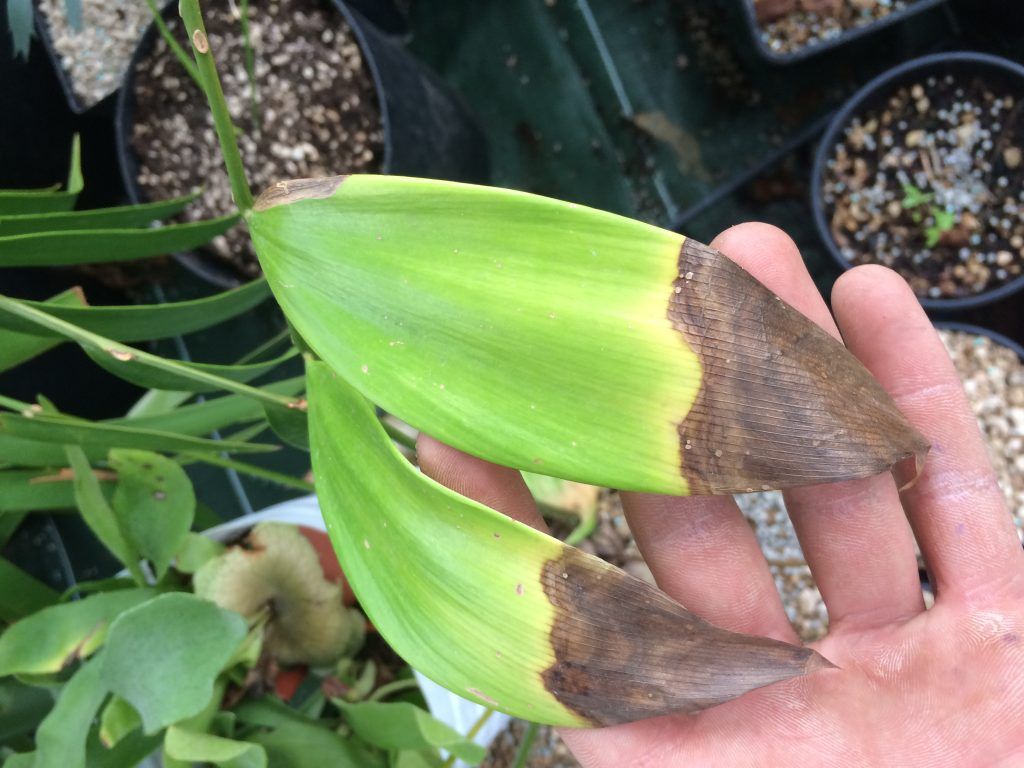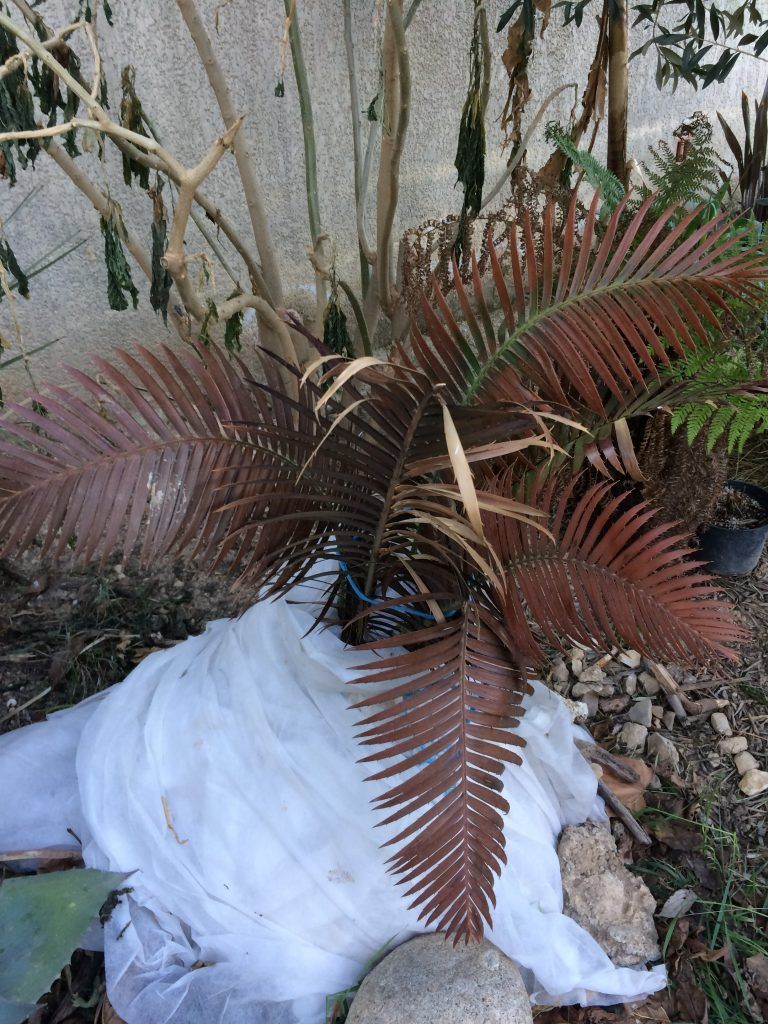This articles is about pathologies frequently found in Europe. Under tropical conditions, pathologies are more diverse and sometimes different.
Insects and otehrs
Continental Europe having no native cycads, we’re lucky to have no specific parasites. Furthermore, the absence of tropical climate is probably what prevented the introduction of parasites of Cycads native countries.
To be noted that insects parasiting these plants in their native regions are very diverse. Can be cited the Cycas Aulacaspis Scale (abbreviated CAS, Aulacaspis yatsumatsui), from SE Asia and being a disaster in many tropical area were it was introduced. Various weevils from South Africa and the Carribeans and the blue cycad butterfly (Theclinesthes onycha). All these species being absent of continental Europe, it’s more than necessary to control and quarantine all plants imported from these regions.
Even with the phytosanitary controls, the risk of introducing a pest exists. It’s what happened with palm trees and the introduction of Paysandisia and Rhyncophorus that ravage the mediterranean area ( it should be noted that cycads are not affected by these pests).
In many tropical area, cycads must be sprayed very frequently to prevent these pests which is not the case (so far) in continental Europe.
Meallybugs : Meallybugs are the most frequently encountered parasites. They thrive on weakened plants and under confined conditions (indoors, greenhouses). These insects who suck the sap often hide on the underside of the leaves, their presence can be noticed with deformed new leaves and discolorations on mature leaves. In the end, the meallybugs can badly damage the plant and even exhaust them to the point of death.
Several methods exist to control these pests : insecticides designed for meallybugs or also pyrethrins for a more organic approach. Another technique consists in using a mis of water, black soap and rubbing alcohol (the drawback is that plants must be treated very often).
One of the main difficulties with meallybugs comes from the fact that they hide in between caudex scales which makes their elimination difficult.
To be noted that because of the slow metabolism and/or the thick leaf cuticle, many systemic insecticides have a low efficacy on cycads .
Snails and slugs : Even if cycads are not gasteropods’ favourite food, they sometimes feed on emerging leaves. It’s important to protect these leaves until they have hardened. Cycads rarely producing leaves more than once or twice a year, it’s necessary to ensure their safe development.
Special case : Tropical Zamia
A phenomenon that isn’t common in Europe (but happens) is the emergence of leaf spots, most often on tropical Zamia. They can be isolated necrotic spot or necrosis starting at the tip of the leaf. It’s usually caused by a fungus named Mycoleptodiscus indica. Usually, the effects are mainly aesthetic under our climates but in extreme case it can spread toward the caudex and kill the plant. The most important step is to cut the affected leaves and dispose of them far from the cultivation area. Then a foliar fungicide can be sprayed. This problem being rare, there haven’t been much trials with products available in Europe.

Rot :
One of the most frequent issue when cultivating cycads is rot, whether roots or caudex. The main flaw of these plants is that when rot is noticed it’s often too late, the base of the leaves becomes soft and the whole caudex collapse.
Root rot is usually caused by a growing medium lacking drainage and/or a root stress (drought, mechanic). It’s hard to judge of the health of the root system as it’s underground but a healthy plant will often have some roots trying to make their way through the pot’s drainage holes.
If root rot is encountered, for exemple while repoting, one must eliminate all damaged roots and treat with a wide spectrum fungicide. The plant can be repoted in an adequate soil while being careful with overwatering to avoid making the problem worse. If the root system is badly damaged, it’s better to cut most of the leaves to avoid water loss.
The other type of rot affects the caudex with most of the time a good root system. It can be caused by a mechanical stress, an excess of top watering (that sometimes happen with top irrigation) or , less often, damages due to borers like weevils.
Usually, this kind of rot is treated by eliminating dead parts and dusting a solid fungicide. Then, watering the healing parts must be avoided. It should be stressed that even if the plant loses a large part of its caudex, it can survive and grow back but it’s a slow process.
Be careful while manipulating plants with a large caudex : shocks can provoke internal lesions that are invisible but may cause rot.
Deficiencies :
To understand how deficiencies emerge, it’s necessary to understand cycads’ metabolism. They’re slow growing plants that will stock starch in their caudex and use it to produce leaves. Thus, we notice the the effects of a deficiency usually appear several months after the deprivation. And the same goes for the fertilisation’s corrective measures : several months or « flushes » (new whorl of leaves) are needed to see beneficial effects. Generally, leaves affected by a deficiency, like nitrogen deficiency making them yellowish, will never become green again.
Nitrogen and Iron : New leaves yellowish that will not revert to green even after fertilizing. Can happen on freshly rooted plants. Be careful with the addition of organic matter in the soil : the Carbon/Nitrogen ratio is to be taken into account. When it’s unbalanced in favor of carbon, bacteries and fungii decomposing organic matter will use a lot of nitrogen in the process, nitrogen that is thus not available for the plant.
Corrective measures for these defficiencies usually consists in regular fertilization. A slow release fertilizer is usually quite effective against this kind of issue. It’s often hard to differenciate iron and nitrogen deficiencies on cycads, hence the need to know the soil and water quality.

Magnesium : Leaflet tip yellowing. One frequent case it Cycas revoluta « aurea » that shows symptoms of the magnesium deficiency. Even if it’s likely that some plants assimilate Mg less than others, these « aurea » are absent of fields properly fertilized. One corrective measure is the use of Epsom salts (magnesium sulfate). In other species, this deficiency shows yellow bands on the leaves.
Manganese : Chlorosis (discoloration) of leaves that can lead to browning. This is a very frequent deficiency , especially for species originating in acidic soils. Indeed, Mn availability is very low at high PH (alkaline) and an abundance of phosphore diminuishes it even more. This deficiency is known under the name « frizzletop ». To avoid this kind of deficiency, sulfure can be added to the soil to lower the pH or Manganese under various forms (manganese sulfate for exemple). Anyway, cycads do not need a lot of this micronutrients.
There are others deficiencies that can appear in some special cases but there’s not much knowledge about them so far. The key is to know the plant’s chemical environment and to fertilize accordingly.
Physical damages :
On the leaves : Several origins regarding leaf damage like hail that makes yellow spots on the leaves and those linked to the plant’s handling. Torn leaves/leaflets usually dry because the vessels carying the sap are cut.
Sunburn happens sometimes when a plant that was grown under shade is moved (greenhouse, indoor plants).
These damages are irreversible but the next leaves should be healty. To be noted that if the leaves are partially green it’s unnecessary to cut them off since they keep bringing energy to the plant.
Leaves can be burnt by the cold, some species handling it better than others. If the caudex wasn’t damaged, new leaves will sprout when temperature has risen.

On the caudex : When handling plants, the caudex can be damaged which is usually seen when the plant produces sap/resin. Sometimes, leaves can break at the base during windy events or when the leaves are stretched and collapse under their own weight. These damages can constitute entry points for fungii and it’s best to treat them accordingly.
Note : When it rains and humidity is high, a king of gelly can be seen. Usually it’s dry sap, due to a previous trauma, that rehydrates and there is no need to worry. At the opposite, if during dry times the plant tends to exudate sap from the caudex, it may be due to internal damage sometimes due to borers.



